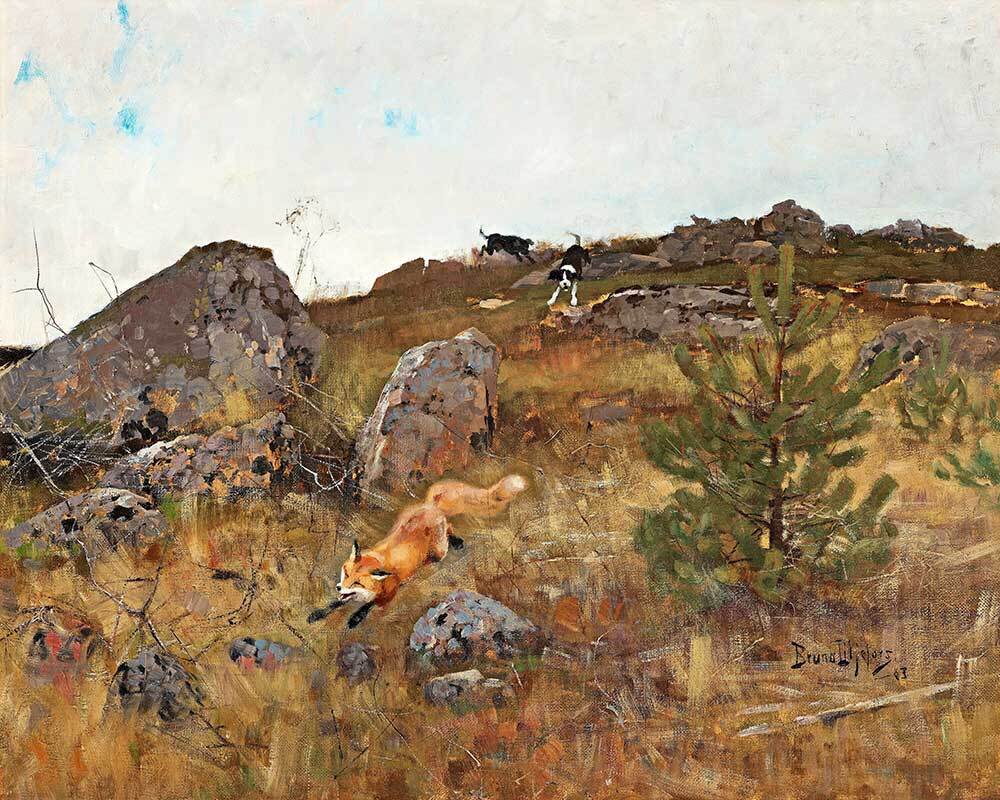Anniversary auctions at Bukowskis presenting "Fox Chased by Hounds" by Bruno Liljefors

Bukowskis presents "Fox Chased by Hounds" by Bruno Liljefors on the anniversary auction Important Winter Sale
Liljefors' study time was short - he decided to leave the art academy prematurely. The defection was entirely in the spirit of the times; student revolt against the academies characterized art education around Europe towards the end of the 19th century. The academies put too much restraint on the students through their teaching methods, the future artists claimed.
Liljefors began his studies at the Academy of Fine Arts in 1879 and became friends with Anders Zorn, who already had a couple of years of studies behind him. Zorn wanted to leave the academy, and Liljefors soon agreed with him. None of them could see that they had anything to learn from drawing plaster copies from the antique. Furthermore, naked guards-men were bad models, especially if you want to paint foxes, Zorn pointed out to Liljefors.
Liljefors, however, seems to have appreciated P.D. Holm, a teacher of landscape painting. This appreciation perhaps came naturally, considering that Holm had previously considered becoming an animal painter and also trained as an animal conservator.
Later, however, Liljefors stated that he learned more from his fellow student Zorn than from the academy's professors. In the memoir "Bruno Liljefors. A Study", 1929, K.E. Russow reports: "Liljefors is happy to admit that he has much to thank his comrades for, especially Anders Zorn, with whom he often exchanged thoughts on the art of painting. Zorn was the first who fully dared to trust the sentence: 'If the colours are correct, one thinks one sees the details of reality.' Very humorously, Liljefors once said that he had painted a fox with great care; when Zorn saw it, he commented that it looked like the hairs of the fur were glued on the body. Zorn took a pad of drawing paper and painted something on it with a lot of watercolour paint and plenty of water. During the conversation, he balanced seemingly carelessly here and there with the paper, Liljefors thought it was part of the joke. But when the sheet was dry, a masterfully painted fox skin was to be seen. Liljefors admits that this demonstration clearly showed 'how to see a thing', which made a deep impression on him".

In the auction's painting from 1883, we see one of Liljefors earliest depictions of a fox. Perhaps, in the free brushwork, relatively speaking, you can trace some of the lessons from Zorn. But also observe how far Liljefors already in this early work has moved away from the at the time common way to portrait animals in nature, which is base on static reproduction - as of posing models.
Liljefors depicts the fox's escape from the dogs with the dynamics of that speed and the exact observation of movement's that would become his trademark as a depictor of wild animals. In this area, he never had to learn anything from his fellow student Zorn.
Estimate: 600 000 - 800 000 SEK / 58 766 - 78 355 EUR
Till "Fox Chased by Hounds"
When is the viewing and auction?
Bukowskis Important Winter Sale
Viewing 4 – 9 december, Berzelii Park 1, Stockholm, Opening hours: Mon–Fri kl 11–18, Sat–Sun kl 11–17
Auction 10 – 11 December, Arsenalsgatan 2, Stockholm
Contact our specialists


























